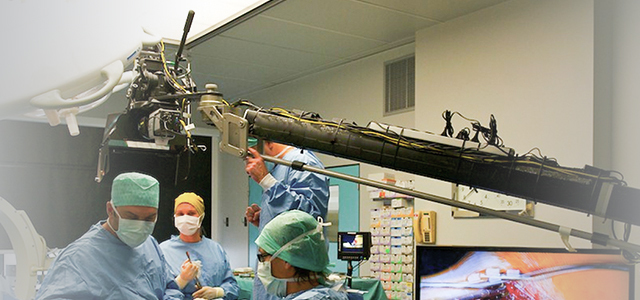Left Main Coronary Artery Ostial Stenosis in a Pediatric Patient With Sudden Cardiac Arrest
A 14-year-old male with bicuspid aortic valve presented after resuscitated ventricular fibrillation cardiac arrest. Bystander cardiopulmonary resuscitation was performed, emergency medical services confirmed ventricular fibrillation, and defibrillated into sinus rhythm with 200 J (Figure 1A). He had been followed by pediatric cardiology for bicuspid aortic valve and a recent echocardiogram demonstrated mild aortic stenosis, no aortic insufficiency, and a mild-moderate dilated ascending aorta. Family history was negative for sudden cardiac death, premature myocardial infarction, syncope, seizure, cardiac channelopathy/cardiomyopathy, congenital heart disease, or pacemaker-defibrillator.

AED Defibrillation, 12-Lead ECG, and Imaging in a Pediatric Patient After Resuscitated Cardiac Arrest
(A) Defibrillation with 200 J for ventricular fibrillation. (B) 12-Lead ECG demonstrating normal sinus rhythm, left ventricular hypertrophy by voltage, and diffuse ST-segment elevation. (C) Cardiac computed tomography (coronal view) demonstrating left main coronary artery ostial stenosis and acute turn of proximal LMCA (red arrow). (D and E) IVUS demonstrating dynamic LMCA ostial stenosis (diastole = light blue tracing; systole = yellow tracing). (D) IVUS imaging of the LMCA distal to the lesion. This region is widely patent with an area of 17.9 mm2. (E) IVUS image at the lesion in the LMCA during compression showing ∼60% narrowing to an area of 7.5 mm2. (F) Cardiac computed tomography (coronal view) demonstrating normal caliber of LMCA with no evidence of ostial stenosis postsurgical repair (yellow arrow). ECG = electrocardiogram; IVUS = intravascular ultrasound; LMCA = left main coronary artery.
Baseline 12-lead electrocardiogram demonstrated normal sinus rhythm, left ventricular hypertrophy by voltage, and diffuse ST-segment elevation (Figure 1B). Echocardiogram demonstrated similar findings to his outpatient echocardiogram; coronary arteries were not adequately visualized. Cardiac magnetic resonance imaging and computed tomography were negative for cardiomyopathy or scarring, but demonstrated narrowing at the origin of the left main coronary artery (LMCA) (1.5 × 1.5 mm compared with 3 × 3 mm distally) with no filling defects/calcification (Figure 1C). Invasive angiography demonstrated a high takeoff of the LMCA, coursing at an acute angle before bifurcation into left anterior descending and circumflex branches; ostial stenosis and dynamic compression of the proximal LMCA were suspected. Intravascular ultrasound (IVUS) demonstrated 60% dynamic occlusion of the LMCA (Figure 1D and 1E). A fasting lipid panel was normal. Surgical intervention was chosen given his young age and the location/dynamic nature of the stenosis. Intraoperative inspection confirmed LMCA ostial stenosis with a slit-like opening, and no intramural segment. Patch arterioplasty of the LMCA was performed using fresh autologous pericardium.
The incidence of pediatric sudden cardiac arrest is ∼2.28/100,000 person-years, but the cause remains undetermined in 40%. LMCA ostial stenosis may occur in isolation or be associated with other coronary artery abnormalities/complex congenital heart disease. Myocardial ischemia from ostial stenosis may be triggered by low flow under high oxygen demand states. In our patient, IVUS illustrated the dynamic nature of the underlying coronary pathology. Current guidelines recommend that patients with low syntax scores (≤22) undergo percutaneous catheter intervention. However, in patients with high anatomical complexities (pediatric patients with isolated LMCA ostial stenosis), caution should be exercised with this approach. We elected to perform patch arterioplasty rather than coronary artery bypass grafting because it will likely lead to better long-term patency. In patients with dynamic obstruction, competitive flow has been linked to coronary artery bypass grafting graft occlusion.
The patient was discharged home after an uneventful recovery. A follow-up has demonstrated a widely patent LMCA with unobstructed flow (Figure 1F). Stress testing showed no arrhythmias or electrocardiogram evidence of myocardial strain/ischemia. Pediatric sudden cardiac arrest warrants comprehensive work-up for an underlying etiology, including coronary artery abnormalities. Additional tools including IVUS can enhance delineation of underlying coronary artery abnormalities and inform optimal interventional approach.
This article is reproduced from JACC journals.
Surgerycast
Shanghai Headquarter
Address: Room 201, 2121 Hongmei South Road, Minhang District, Shanghai
Tel: 400-888-5088
Email: surgerycast@qtct.com.cn
Beijing Office
Address: room 709, No.8, Qihang international phase III, No.16, Chenguang East Road, Fangshan District, Beijing
Tel: 13331082638( Liu )
Guangzhou Office
Address: No. 15, Longrui street, longguicheng, Taihe Town, Baiyun District, Guangzhou
Tel: 13302302667 ( Ding )






